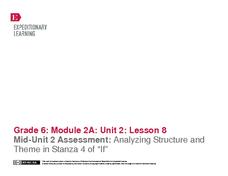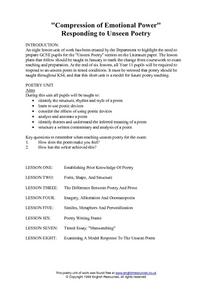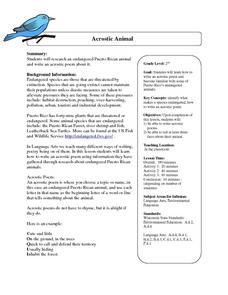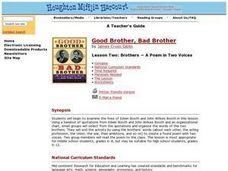EngageNY
Analyzing Structure and Theme in Stanza 4 of “If”
Here is a lesson that provides scholars with two opportunities to stretch their compare-and-contrast muscles. First, learners compare and contrast their experience reading the fourth stanza of If by Rudyard Kipling to listening to the...
Curated OER
Archetypal Images and Polarities
Here is a rather esoteric resource that presents the archetypes found in “The Epic of Gilgamesh,” and would be appropriate for a college-level psychology or literature class, or as a teacher resource. Considered the “world’s oldest...
Curated OER
The Poetry of Chinoiserie
Students study Asian works of art and Japanese haiku. They then take this knowledge and create an original haiku in response to other works of art.
Curated OER
What is Poetry and Where Can You Find It?
Students examine different types of poetry in music, commercials and printed works. They identify themes of philanthropy in poetry as well. They finally share their findings with the class.
Curated OER
"Compression of Emotional Power"--Responding To Unseen Poetry
Eleventh graders identify the structure, rhythm and style of a selected poem, experience utilizing poetic devices and analyze an annotated poem. They evaluate the themes and inferred meanings to a variety of poems from their textbooks.
Curated OER
Acrostic Animal
Second graders listen as the teacher describes how an acrostic poem is written. They research an endangered animal of Puerto Rico. Students write an acrostic poem as a class, and then individually about the animal they research. Students...
Curated OER
Poetry on the Web
Eighth graders search a website and locate a poem written by a specific poet whose work appears in the grade 8 anthology. After listening to poetry, 8th graders present oral or written examples of imagery and an analysis of the imagery.
Curated OER
Pictures in Words: Poems of Tennyson and Noyes
Eleventh graders describe and analyze the effects of poetry on readers. They participate in an Internet scavenger hunt, an exercise involving interpretation of poetry through visual art, and an opportunity for students to create their...
Curated OER
Color A Rhyme: Mitten Lost & Found
In this rhyming word worksheet, students listen as the teacher reads each of 10 phrases. They complete each of the little poems with the missing rhyme. They color the mitten that fits the rhyme.
Houston Teachers Institute
Alice in Wonderland: Nonsense and Logic in Literature
Alice's Adventures in Wonderland is known for its fantastical imagery and nonsense verse. This unit plan offers a basic exploration into nonsense verse through poetry and teacher read-alouds. It incorporates activities involving...
K12 Reader
The Man Has a Can
Add this -an word resource into your plan for the day! Kids can read the poem, which includes several -an words to practice with, and then answer the three included reading comprehension questions.
K12 Reader
The Snow Blows
Brrr! It's cold outside when it snows. Have your class read this poem about the snow to practice the long /o/ sound, -ow words, and reading comprehension. After reading, they respond to three questions.
Arkansas Government
Creative Adventures with Literature - Whoever You Are
Celebrate our similarities and differences through multiple readings of Whoever you Are by Mem Fox. Readings are accompanied by a grand discussion, charts, creative art, dramatic, and music play to reinforce the uniqueness that is...
Voices of a People's History
Voices in The Classroom
Everyone's perspective of the past is different. A thought-provoking unit gives young academics the opportunity to explore their perspectives on history and their neighborhoods. Based on the work of Howard Zinn, each lesson explores...
Simon & Schuster
Classroom Activities for The Call of the Wild by Jack London
Three activities are designed for readers of Jack London's The Call of the Wild. First, class members research and create posters that reflect the setting of the novel. Next, groups create posters with images that represent each chapter...
Curated OER
Good Brother, Bad Brother: The Story of Edwin Booth and John Wilkes Booth
Students examine the lives of Edwin Booth and John Wilkes Booth. They create a "found" poem using the voices of both brothers and perform the poem for the rest of the class.
Curated OER
You Too Can Haiku: How to Write a Haiku
Students explore language arts by writing their own poems. In this haiku instructional activity, students investigate the Japanese culture and their beautiful music, poetry and art. Students count the syllables in every line of a haiku...
Curated OER
What has Year 7 Got in Store for You?
In this poetry worksheet, students write their fears and hopes for the year and then write an acrostic poem spelling out year seven. Students answer three short answer questions.
Curated OER
Mutability Questions
For this poetry analysis worksheet, students read the poem "Mutability," by William Wordsworth and then respond to 6 discussion questions. The questions require students to consider the role of religion and the impact of sudden change as...
Curated OER
The Search for Character!
Fifth graders define character words, look for real-life examples of the traits "in action," and write an acrostic poem based on one of these qualities.
Curated OER
Writing Places
Students brainstorm ideas after being read a poem and then are to write their own poem and read them out loud.
Curated OER
Historical Maryland Women
Learners identify objects, activities, and people in pictures of women in Maryland's history. In groups of four, they analyze photo packets of historical women. Students complete an acrostic using phrases reflecting specific...
Curated OER
Valentine's Day
Students create a flower, poem, and mailbox for someone to open on Valentine's Day. In this Valentine's Day lesson plan, students also write Valentine letters.
Curated OER
Creating Found Poetry From Picture Books
Young scholars use picture books to identify poetic elements and word choice. They create a "found poem".























